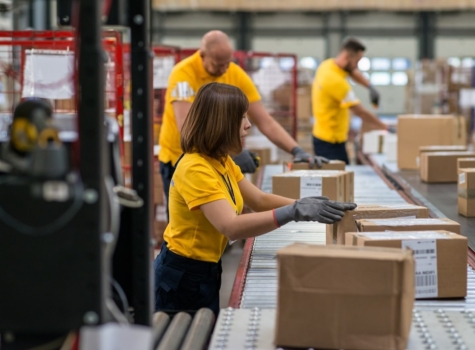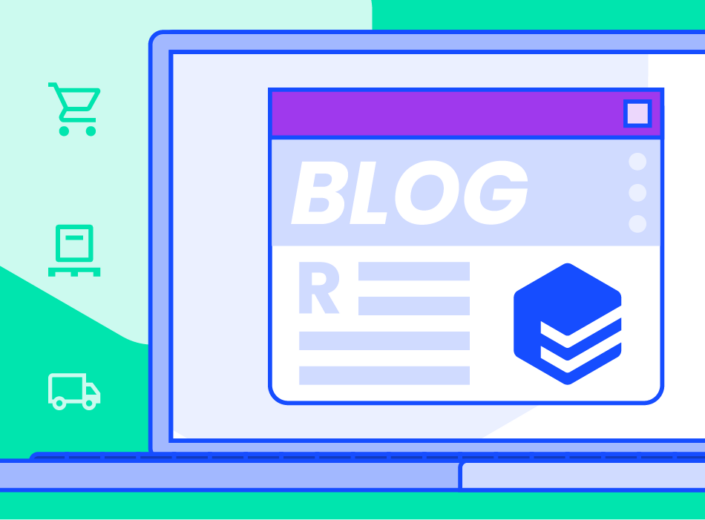Imagine a customer browsing your ecommerce website. After adding several products to their cart, they click the check out button, enter their payment and shipping details, and complete the purchase. Now, all they have to do is wait for their product to arrive. Simple!
For your business, on the other hand, a complex process has just been set in motion. That process is called order fulfillment, and it’s a critical component of your ecommerce fulfillment operations.
This article will explain the what, why, and how of order fulfillment for ecommerce. Ready to dive in?
What is ecommerce fulfillment?
Ecommerce fulfillment is the process of shipping products to customers; it involves receiving and storing goods, picking and packing orders, and transporting packages to consumers’ addresses. Effective ecommerce fulfillment relies on seamless coordination.
The fulfillment process involves lots of moving pieces, including distribution centers, workers, packaging materials, and technology. When those ecommerce fulfillment pieces don’t work together well, you can face issues like late, lost, or damaged packages.
The ripple effect? Your brand image suffers, once-loyal customers stop coming back, and potential customers choose your competitors instead.
On the other hand, a well-designed ecommerce fulfillment process minimizes delivery issues, helping you gain and retain customers.
How a great order fulfillment process can drive success for your business
Customers have high expectations when ordering things online. They prefer—and in many cases expect—fast, accurate, and affordable shipping. That’s why designing a great ecommerce fulfillment process is key to improving customer satisfaction.
Those who order your products will be pleased with a quick, convenient delivery experience and be open to buying from you again. A top-tier ecommerce fulfillment operation shows customers you care about timely delivery. And if first-time site visitors learn that you offer fast delivery, package insurance, sustainable shipping, and other perks, they’ll feel more comfortable making purchases.
The order fulfillment process impacts your business in other ways too. Inefficient warehouse processes cost time and money, so it’s in your best interest to eliminate inefficiencies through technology and strategic changes.
The following examples demonstrate how improving just one element of order fulfillment—shipping—helped businesses save money and time.
- Winestyr saved 200+ hours per year and boosted overall efficiency by 10%
- Sticker Mule saved $6,000 per month
- XPS increased label creation speed by 14 times, allowing them to ship over 1 million packages per month
How to execute ecommerce fulfillment like a pro
Ecommerce fulfillment will look different for every business. For very small businesses, the process might be mostly manual. The business owner receives inventory, organizes and stores it at home, creates shipping labels, and drives packages to the carrier office.
As organizations expand, so do their ecommerce fulfillment operations. The garage is replaced by a warehouse where trucks unload inventory. Products are stored on shelves or in bins, and sophisticated warehouse management systems help workers find them when it’s time to assemble packages.
Whatever your business’s size, it’s crucial to optimize order fulfillment. In this section, we’ll walk through the ecommerce fulfillment process from start to finish for businesses that operate their own distribution centers (the general principles still apply if you run your business from home).
Step 1: Receiving
The first step of the order fulfillment process is receiving. During this stage, products arrive at your distribution centers, where staff members unload, inspect, and add them to your inventory management system. Once new inventory is added to your system, customers browsing your online store can see that it’s available.
Tips for effective receiving:
- Use technology. Use barcode scanners and inventory management software to quickly log new products into your system. This not only reduces errors but also decreases the time it takes to update your online store’s inventory.
- Prioritize quality control. Place a strong emphasis on quality control during the receiving stage. Workers should thoroughly inspect incoming products to make sure nothing is damaged or missing.
Step 2: Storage and inventory management
Once inventory has been unloaded and inspected, you’ll store it until customers place their orders. The aisles, shelves, racks, and bins of warehouses are labeled, and each SKU (stock keeping unit) has a predetermined location, which the warehouse management system (WMS) keeps track of. This makes it easy for warehouse staff to distribute stock throughout the facility.
Tips for effective storage:
- Store popular items near the packing station. You can save time for pickers by storing high-demand products close to packing stations. Since these products will need to be picked frequently, storing them near packing stations makes the process more efficient.
- Make sure products don’t get mixed up. Storing similar products close together might sound like a good idea at first, but it can lead to mixups (like grabbing a size medium sweater instead of a size large). To avoid this, keep similar products apart in the warehouse.
Inventory management is the ongoing process of receiving and organizing stock, monitoring inventory levels, and ordering the right amount of each product to meet customer demand. Good inventory management techniques will help you avoid both stockouts and overstocks. These are each harmful in their own way; running out of inventory means missing out on sales, but having excess stock costs more in storage and ties up cash.
Tips for effective inventory management:
- Establish reorder points. A reorder point is the minimum amount of a product you keep in stock. Once stock levels reach the reorder point, you’ll know it’s time to order more. Define reorder points for each product based on historical sales data and lead times.
- Implement just-in-time (JIT) inventory. Consider adopting a just-in-time approach to inventory management to minimize storage costs and improve cash flow. With JIT, you order and receive inventory only as needed, reducing excess stock and associated holding costs.
Step 3: Picking and packing
When a customer makes an online purchase, the WMS generates a packing slip that includes the exact location of each product in their order. Then workers use technology, as well as your predetermined picking strategy, to gather the products and bring them to a packing station. There, other staff members put products in the right boxes, seal them, and add the appropriate shipping labels.
Bottlenecks in your distribution centers can lead to delayed deliveries. To keep your customers’ shipments on time, ensure that picking and packing processes run smoothly and efficiently.
Tips for an effective pick and pack process:
- Optimize warehouse layout for efficient picking. Design your warehouse layout with picking efficiency in mind. Whether you organize storage by product categories, popularity, or another factor, the system should be logical and organized.
- Conduct quality checks at packing stations. Packing is your last chance to make sure that products are undamaged and orders are complete. Train staff to carefully inspect each item, verify the order against the packing slip, and confirm that the correct shipping labels are applied.
Step 4: Shipping
Finally, it’s time to send packages to customers! Each package gets a shipping label, which you can create automatically using shipping software. These labels provide carriers with all the information they need to know to deliver packages.
Once each package has a label attached, you schedule a carrier pickup. From there on out, the carrier takes responsibility for safely delivering packages.
Tips for effective shipping:
- Be transparent. Transparency about shipping costs, delivery times, and available carriers helps manage customer expectations. Clearly communicate any shipping fees and provide real-time tracking information.
- Optimize packaging for cost-efficiency and product safety. Efficient packaging not only saves on shipping costs but also ensures that products arrive in good condition. Optimize your packaging process to minimize wasted space, choose sturdy packaging materials, and make sure products are secured.
- Use free shipping strategically. Free shipping can be a major draw for consumers, so use it to your advantage. For example, you might offer free shipping on orders over a certain value or during promotional periods. You could even build the cost of shipping into the product prices to offer “free” shipping without increasing costs.
Determining the best shipping carrier
Shipping can be costly, but the right carriers and shipping services will save your business money.
Should you use USPS, UPS, FedEx, or a regional carrier? That’s a trick question! Rather than choosing just one, you can (and should) diversify your carrier mix. With a shipping API like EasyPost, you can connect with over a hundred carriers and automatically identify the most cost-effective ways to ship packages.
Prefer to research and select carriers yourself? When making your decision, consider the following factors:
- Location
- Product type
- Shipping volume
- Product weight
- Delivery time
- Cost
- Quality of service
This article explains each of these factors in more depth.
Step 5: Returns
Shipping isn’t the final step in the ecommerce fulfillment process—that would be returns, also known as reverse logistics.
The returns process involves receiving products, assessing their condition, and deciding what to do with them. If a product is still unopened, you might simply add it back to your available stock. Products with minor damage can be refurbished and sold at a discount or donated to thrift stores. If a returned item is damaged beyond repair, it probably needs to be discarded or recycled.
Tips for effective returns:
- Keep your customer in mind. Making customers jump through hoops to return a product might save you money in the short term, but it could lose you customers in the long term. Design a returns experience that’s easy and smooth for your buyers.
- Provide a return label. To save money on return shipping, you might decide to simply offer refunds and allow customers to keep the product. However, if you decide to have returns shipped back, give customers a digital or physical return label and provide detailed instructions for packaging and shipping their product.
One integration, infinite flexibility
Many shipping platforms limit you to a small number of carriers, forcing you to compromise on shipping options or manage multiple integrations. EasyPost’s Shipping API changes that by offering seamless access to over 100 carriers. This includes USPS, UPS, FedEx, DHL, and many regional providers through a single, modern API.
This means you don’t have to juggle different systems or worry about switching carriers as your business grows. Whether you need to scale quickly during peak seasons, handle complex international shipments, or offer customers more delivery choices, EasyPost’s Shipping API provides the flexibility to adapt your shipping strategy without additional technical overhead.
With one integration, you can easily compare rates, track packages in real time, generate labels, and manage returns—all in one place. This simplifies your workflow, reduces costs, and helps you deliver a better experience to your customers.
Ecommerce fulfillment options
What are your options for handling order fulfillment? The two most popular options for ecommerce businesses are in-house and outsourced, but we’ll run through three other methods as well: Amazon FBA, hybrid, and dropshipping.
In-house
When you handle ecommerce fulfillment in-house, you keep logistics functions within your business.
Small, newly-founded businesses usually operate out of a home, while more established ones operate out of one or more distribution centers.
As businesses grow, in-house logistics becomes more involved. It’s not as simple as putting products in boxes and shipping them; managing fulfillment for a growing ecommerce store involves the following tasks (and more):
- Finding and paying for warehouse space (and utilities)
- Recruiting and training staff
- Buying equipment, materials, and software
Fulfilling orders internally allows you complete control over every step of the fulfillment process. When you directly oversee inventory management, picking, packing, and shipping, you ensure a high-quality experience for customers.
Third-party logistics
Third-party logistics providers (3PLs) are outsourced logistics partners that own and operate distribution centers. When you work with a 3PL, they handle the day-to-day tasks of order fulfillment. You send them your inventory, and they store, pick, pack, and ship it to customers.
This approach is more low-maintenance than in-house ecommerce fulfillment, and for medium-sized and large businesses, it can save money. However, outsourcing logistics has its downsides. For one thing, it decreases your control of the fulfillment process. Additionally, some 3PLs aren’t transparent about costs, and the fees they charge for each service quickly add up.
If you’re considering using a 3PL, look for one that’s transparent about their pricing and has distribution centers located near your customer bases.
Amazon FBA
Many businesses selling on the Amazon Marketplace use Fulfillment by Amazon (FBA), Amazon’s outsourced order fulfillment service. This gives them access to Amazon Prime shipping, as well as the other benefits of outsourced ecommerce fulfillment.
But FBA isn’t always cost-effective. In addition to paying a high Amazon Seller fee, you also have to pay storage costs. FBA also requires a minimum sales volume that small businesses may struggle to meet.
Hybrid
With a hybrid ecommerce fulfillment strategy, businesses fulfill some of their orders themselves and outsource the rest. Some organizations pair in-house fulfillment with FBA; Since Amazon’s warehouse space is limited during busy seasons, these businesses can continue shipping orders themselves even when they can’t restock in an FBA warehouse.
Dropshipping
Dropshipping allows you to sell online without much initial investment. You source products from suppliers but only pay for inventory once someone has placed an order. The supplier ships the order to the customer, and you keep the profits.
This method eliminates the need to run your own warehouse or partner with a 3PL, but you make less on each product because the supplier takes a cut.
How much does ecommerce fulfillment cost?
The cost of order fulfillment differs depending on the method you use (in-house vs. outsourced), your products (specialized items may have unique packing or shipping requirements), and carrier fees. In this section, we’ll break down the costs associated with in-house and outsourced fulfillment.
The cost of in-house ecommerce fulfillment
When fulfilling orders yourself, you don’t just pay for packaging materials and postage. To understand the true costs, you need to look at the whole picture.
- Warehouse space. In 2022, the average rent per square foot for distribution centers was $8.84.
- Warehouse utilities. It costs money to get electricity, water, and heat in your warehouse.
- Equipment and software. Equipment might include forklifts or conveyor systems. Software can include a WMS, order management system (OMS), picking software, and shipping platform.
- Labor. You’ll need to pay your staff. According to Indeed, the average salary for an entry-level warehouse worker in 2024 is $17.08 per hour, while warehouse managers make $65,000 or more per year.
- Workers’ compensation. The average cost of workers’ comp in the U.S. is $1.19 per $100 of payroll.
- Packing supplies. This includes boxes, mailers, filler material, tape, ink, and blank shipping labels.
- Shipping rates. Rates are based on package weight dimensions and weight, as well as shipping distance. To get an estimate of shipping costs for major carriers, visit the USPS, UPS, or FedEx rate calculators. Keep in mind that carriers often add surcharges for things like fuel and residential delivery.
- Shipping insurance. Insurance costs are usually between 1% and 3% of a product’s value.
- Duties and taxes. When shipping internationally, you’ll need to pay duties and taxes.
An easy way to decrease the costs of in-house ecommerce fulfillment? Use a shipping platform to integrate with carriers, access special discounted rates, and avoid costly shipping errors.
The cost of outsourced ecommerce fulfillment
Third-party logistics provider ShipBob, an EasyPost partner, breaks down the costs of outsourced ecommerce fulfillment in this article. The table below lays things out—just keep in mind that each 3PL’s prices differ. For the most accurate cost estimate, contact your 3PL directly.
|
Service
|
Cost
|
|
Receiving
|
$35 for the first two hours
|
|
Storage
|
Monthly: $40 per pallet, $10 per shelf, $5 per bin
|
|
Pick and pack
|
First four picks are free; after that, $0.25 per pick
|
|
Standard packaging
|
Free
|
|
Kitting
|
Flat fee for the project (e.g. $25), each additional touch $0.04 – $0.50 per unit or kit
|
|
Shipping
|
Varies
|
Improve your ecommerce fulfillment process
Ecommerce fulfillment looks a little different for every organization, but the most successful companies have one thing in common: they rely on technology integrations to streamline their processes.
If you’re looking for ways to optimize your order fulfillment, we recommend getting started with the EasyPost suite of shipping APIs. With solutions for carrier integration, label generation, address verification, insurance, package tracking, delivery optimization, and more, EasyPost has everything you need to ship your products to customers.



